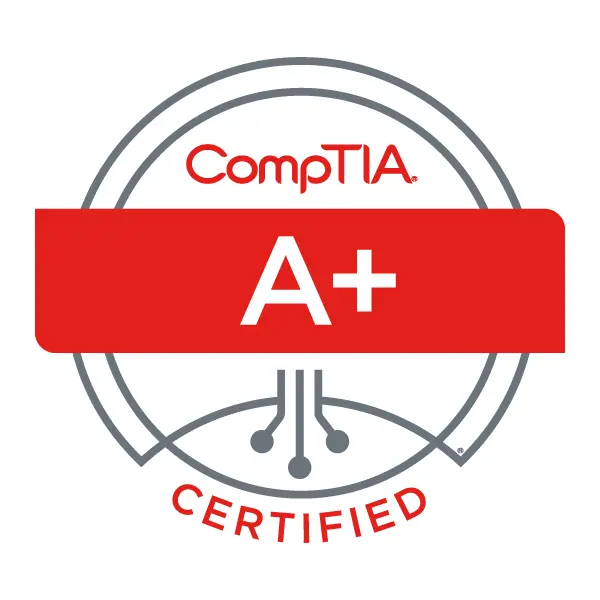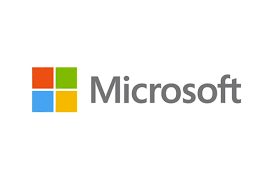Skaffa nya IT-kunskaper, bli certifierad och lyft din IT-karriär till nya höjder utan att spränga banken!
Unlimited Training - IT kurser och certifieringar gjort enkla och otroligt billiga. Få tillgång till 60+ LIVE-kurser för mindre än priset för en kurs.











course: CompTIA A+
Varighet: 5 days
Format: Virtual or Classroom
![]() Förbereder till Examen :
Comptia A+ Certification Exam: Core 1 (220-1001)
Comptia A+ Certification Exam: Core 2 (220-1002)
Förbereder till Examen :
Comptia A+ Certification Exam: Core 1 (220-1001)
Comptia A+ Certification Exam: Core 2 (220-1002)
![]() Förbereder till Certifiering :
CompTia A+
Förbereder till Certifiering :
CompTia A+
Att uppnå CompTIA A+ certifieringen är inte en lätt uppgift, men med ditt Readynez kurs och Learning Program har vi gjort allt vi kan för att stötta dig från början till slut, för att säkerställa att du har de optimala förutsättningarna för att lyckas. Det inkluderar de bästa tillgängliga resurserna för att hjälpa dig att förbereda dig, inklusive relevanta online kurser, tillgång till praktiska labs, Practice Test för examensförberedelser, study guides, examensstöd och guider etc, allt gjort lättillgängligt för dig i vår Learning Platform. Väljer du vårt virtuella träningsalternativ bidrar du också till en mer hållbar värld med en minskning av CO2-utsläpp på 96% jämfört med alternativet i klassrummet.

Readynez är den bästa utbildningsleverantören jag har använt på många år. Deras kundservice är förstklassig, priserna är mycket konkurrenskraftiga och instruktörerna är excellent.

Lätt att delta över Teams och en utmärkt instruktör gav mig stort värde för den tid jag investerade.
Ditt personliga Learning Program ger dig de färdigheter du behöver så att du kan göra mer av det du älskar. Learning Programmet's tre steg är utformade så att du lär dig nya färdigheter som kommer att öppna upp nya möjligheter för dig.

Readynez365 plattformen erbjuder en digital väg för alla dina inlärningsresurser, från förberedelser till examen, vilket gör det till en smidig väg till nya tekniska färdigheter. Välj vad du vill (och har behov av) för att bli redo. Allt är gjort klart för dig i Readynez365 i god tid för dina utbildningar.
Utbildningsmetodiken är designad till det virtuella klassrummet med fokus på att inspirera och engagera dig med en blandning av praktisk utbildning, presentationer, tekniska labbar och tester. Virtuell utbildning uppskattas också av ledare då det är det mest kostnadseffektiva sättet att utbilda på.
Det finns ett maximalt antal deltagare på utbildningen för att säkerställa enkel tillgång till personlig coaching. Du möter ackrediterade expertinstruktörer som är erfarna IT-proffs och konsulter, certifierade på högsta nivå och som tar med verkligheten in i undervisningen.
Vi täcker alla detaljer så du kan använda det i ditt dagliga arbete och du kommer även lära dig detaljerna du behöver för att klara din examen. Det är ditt beslut om du vill genomföra examen eller inte men med våra detaljerade examensguides och hotline gör vi det enkelt för dig att få tillgång till dina examensvouchers och planera och genomföra din examen online.
Din tillgång till utbildning är obegränsad och du kan utbilda dig så mycket du vill tills du klarar din examen.
Lär dig med gott samvete med utbildningar som ger 96% lägre CO2-utsläpp jämfört med klassrumsutbildning. Vår organisation arbetar med minimal miljöpåverkan och vi har reducerat CO2-utsläppen med 96% sedan 2019. Vi följer ISO 14001 genom hela leveransprocessen som din garanti för hållbar utbildning.
- Givet ett scenario, konfigurera inställningar och använd BIOS/UEFI-verktyg på en PC.
- Förklara betydelsen av moderkortskomponenter, deras syfte och egenskaper.
- Jämför och kontrast olika RAM-typer och deras funktioner.
- Installera och konfigurera PC-expansionskort.
- Installera och konfigurera lagringsenheter och använd lämpliga media.
- Installera olika typer av processorer och tillämpa lämpliga kylningsmetoder.
- Jämför och kontrast olika PC-anslutningsgränssnitt, deras egenskaper och syfte.
- Installera ett nätaggregat baserat på givna specifikationer.
- Givet ett scenario, välj lämpliga komponenter för en anpassad PC-konfiguration för att möta kundens specifikationer eller behov.
- Jämför och kontrastera typer av displayenheter och deras funktioner.
- Identifiera vanliga PC-kontakttyper och tillhörande kablar.
- Installera och konfigurera vanliga kringutrustningar.
- Installera SOHO multifunktionsenhet/skrivare och konfigurera lämpliga inställningar.
- Jämföra och kontrastera skillnader mellan de olika utskriftsteknikerna och den tillhörande bildbehandlingsprocessen.
- Utför lämpligt skrivarunderhåll, givet ett scenario.
- Identifiera olika typer av nätverkskablar och kontakter.
- Jämför och kontrastera egenskaperna hos kontakter och kablar.
- Förklara egenskaper och egenskaper hos TCP/IP.
- Förklara vanliga TCP- och UDP-portar, protokoll och deras syfte.
- Jämför och kontrast olika WiFi-nätverksstandarder och krypteringstyper.
- Givet ett scenario, installera och konfigurera SOHO trådlös/trådbunden router och tillämpa lämpliga inställningar.
- Jämför och kontrast typer av Internetanslutningar, nätverkstyper och deras funktioner.
- Jämför och kontrastera nätverksarkitekturenheter, deras funktioner och egenskaper.
- Givet ett scenario, använd lämpliga nätverksverktyg.
- Installera och konfigurera hårdvara och komponenter för bärbar dator.
- Förklara komponenternas funktion i displayen på en bärbar dator.
- Givet ett scenario, använd lämpliga bärbara funktioner.
- Förklara egenskaperna hos olika typer av andra mobila enheter.
- Jämför och kontrast tillbehör och portar på andra mobila enheter.
- Givet ett scenario, felsök vanliga problem relaterade till moderkort, RAM, CPU och ström med lämpliga verktyg.
- Givet ett scenario, felsök hårddiskar och RAID-arrayer med lämpliga verktyg.
- Givet ett scenario, felsök vanliga video-, projektor- och displayproblem.
- Givet ett scenario, felsök trådbundna och trådlösa nätverk med lämpliga verktyg.
- Givet ett scenario, felsök och reparera vanliga problem med mobila enheter samtidigt som du följer lämpliga procedurer.
- Givet ett scenario, felsök skrivare med lämpliga verktyg.
- Jämför och kontrastera olika funktioner och krav från Microsofts operativsystem (Windows Vista, Windows 7, Windows 8, Windows 8.1).
- Givet ett scenario, installera Windows PC-operativsystem med lämpliga metoder.
- Med tanke på ett scenario, använd lämpliga Microsofts kommandoradsverktyg.
- Givet ett scenario, använd lämpliga funktioner och verktyg för Microsofts operativsystem.
- Givet ett scenario, använd Windows Kontrollpanelens verktyg.
- Givet ett scenario, installera och konfigurera Windows-nätverk på en klient/skrivbord.
- Utför vanliga förebyggande underhållsprocedurer med lämpliga Windows OS-verktyg.
- Identifiera vanliga funktioner och funktionalitet för Mac OS och Linux operativsystem.
- Givet ett scenario, ställ in och använd virtualisering på klientsidan.
- Identifiera grundläggande molnkoncept.
- Sammanfatta egenskaperna och syftet med tjänster som tillhandahålls av nätverksanslutna värdar.
- Identifiera grundläggande funktioner i mobila operativsystem.
- Installera och konfigurera grundläggande nätverksanslutning för mobila enheter och e-post.
- Sammanfatta metoder och data relaterade till synkronisering av mobila enheter.
- Identifiera vanliga säkerhetshot och sårbarheter.
- Jämföra och kontrastera vanliga förebyggande metoder.
- Jämför och kontrastera skillnader mellan grundläggande säkerhetsinställningar för Windows OS.
- Givet ett scenario, implementera och tillämpa bästa säkerhetspraxis för att säkra en arbetsstation.
- Jämför och kontrast olika metoder för att säkra mobila enheter.
- Med tanke på ett scenario, använd lämpliga metoder för datadestruktion och bortskaffande.
- Givet ett scenario, säkra SOHO trådlösa och trådbundna nätverk.
- Givet ett scenario, felsök problem med PC-operativsystem med lämpliga verktyg.
- Givet ett scenario, felsök vanliga datorsäkerhetsproblem med lämpliga verktyg och bästa praxis.
- Givet ett scenario, felsök vanliga mobila operativsystem och applikationsproblem med lämpliga verktyg.
- Givet ett scenario, felsök vanliga mobila operativsystem och applikationssäkerhetsproblem med lämpliga verktyg.
- Givet ett scenario, använd lämpliga säkerhetsprocedurer.
- Med tanke på ett scenario med potentiell miljöpåverkan, tillämpa lämpliga kontroller.
- Sammanfattaprocess för att ta itu med förbjudet innehåll/aktivitet och förklara integritets-, licensierings- och policykoncept.
- Visa korrekt kommunikationsteknik och professionalism.
- Givet ett scenario, förklara felsökningsteorin.
Möt några av de instruktörer du möter på din kurs. De är experter, passionerade inom sina områden och dedikerade till att hjälpa de som vill lära sig, utforska och bli framgångsrika i sina karriärer.

Kevin Henry är en globalt erkänd expert som i över 20 år har bidragit till att utbilda och certifiera människor inom IT-säkerhet, inklusive CISSP, CISM, CISA och andra.

James Rowney är en välkänd expert med över 20 års bidrag till utbildning av IT-säkerhetsfärdigheter.

Friedhelm har mer än 30 års erfarenhet inom IT, säkerhet och datasekretess som senior informationssäkerhetskonsult.
På Readynez tillhandahåller vi många resurser och har erfarna experter på området. Det är därför vi också är mycket framgångsrika med många nöjda kunder. Du kan därför tryggt gå din kurs hos oss. För att gå Comptia A+-kursen krävs dock några förkunskaper.
Du har den perfekta utgångspunkten för att ta den här kursen med dessa förkunskaper:
Med 15 års erfarenhet och fler än 50.000 nöjda kunder från hela världen litar organisationer som ALSO, ATEA, Microsoft, Serco och många fler på Readynez att utbilda och certifiera deras medarbetare.
![[Dictionary item: Green-check]](/images/green-check.png) Toppbetyg på kurser där flest deltagare ger kursen 10/10
Toppbetyg på kurser där flest deltagare ger kursen 10/10![[Dictionary item: Green-check]](/images/green-check.png) 50.000 deltagare utbildade och certifierade
50.000 deltagare utbildade och certifierade![[Dictionary item: Green-check]](/images/green-check.png) Globalt erkända expertinstruktörer, flertalet MVP
Globalt erkända expertinstruktörer, flertalet MVP![[Dictionary item: Green-check]](/images/green-check.png) Pålitlig leverantör av stora utbildningsprojekt för många stora organisationer
Pålitlig leverantör av stora utbildningsprojekt för många stora organisationerDetta är bara några av de många organisationer som litar på Readynez





Att uppnå CompTIA Linux + Powered by LPI (Level 1) certifieringen är inte en lätt uppgift, men med ditt Readynez kurs och Learning Program har vi gjort allt vi kan för att stötta dig från början till slut, för att säkerställa att du har de optimala förutsättningarna för att lyckas. Det inkluderar de bästa tillgängliga resurserna för att hjälpa dig att förbereda dig, inklusive relevanta online kurser, tillgång till praktiska labs, Practice Test för examensförberedelser, study guides, examensstöd och guider etc, allt gjort lättillgängligt för dig i vår Learning Platform. Väljer du vårt virtuella träningsalternativ bidrar du också till en mer hållbar värld med en minskning av CO2-utsläpp på 96% jämfört med alternativet i klassrummet.
SE KURSAtt uppnå CompTia Network+ certifieringen är inte en lätt uppgift, men med ditt Readynez kurs och Learning Program har vi gjort allt vi kan för att stötta dig från början till slut, för att säkerställa att du har de optimala förutsättningarna för att lyckas. Det inkluderar de bästa tillgängliga resurserna för att hjälpa dig att förbereda dig, inklusive relevanta online kurser, tillgång till praktiska labs, Practice Test för examensförberedelser, study guides, examensstöd och guider etc, allt gjort lättillgängligt för dig i vår Learning Platform. Väljer du vårt virtuella träningsalternativ bidrar du också till en mer hållbar värld med en minskning av CO2-utsläpp på 96% jämfört med alternativet i klassrummet.
SE KURSThe Virtual Classroom is an online room, where you will join your instructor and fellow classmates in real time. Everything happens live and you can interact freely, discuss, ask questions, and watch your instructor present on a whiteboard, discuss the courseware and slides, work with labs, and review.
Yes, you can sit exams from all the major Vendors like Microsoft, Cisco etc from the comfort of your home or office.
With Readynez you do any course form the comfort of your home or office. Readynez provides support and best practices for your at-home classroom and you can enjoy learning with minimal impact on your day-to-day life. Plus you'll save the cost and the environmental burden of travelling.
Well, learning is limitless, when you are motivated, but you need the right path to achieve what you want. Readynez consultants have many years of experience customizing learner paths and we can design one for you too. We are always available with help and guidance, and you can reach us on the chat or write us at info@readynez.com.
Datum:
Tider:

